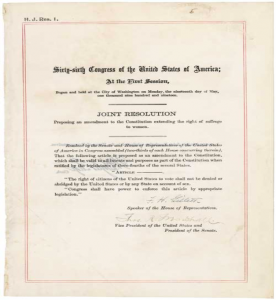Letter to the Convention of the Women of America, Jeanne Deroin and Pauline Roland, 1851
This letter was written by Jeanne Deroin and Pauline Roland in 1851. During the mid 1800s and prior, the Women’s Rights Movement was essentially non-existent. But with groups such as the Convention of the Women of America, women started to feel a sense of empowerment and duty to begin fighting for their rights. Within this letter, Deroin and Roland shared that they are imprisoned for speaking on behalf of women and attempting to fight for the rights of women. They go on to say that the news of the birth of the convention has served as a rallying cry and source of hope for the women within the prison. The content and context of this letter are very important in the grand scheme of the Women’s Rights Movement because the convention served as one of the first places women could join and have a shared sense of unity in regard to the topic of inequality. This letter shows how the convention served as a beacon of movement and helped the movement gain more traction during the mid 1800s.
Women’s Suffrage Speech, Susan B. Anthony, 18712

One of the most impactful actions during the long history of the Women’s Rights Movement was Susan B. Anthony’s speech that was given during her trial when she attempted to vote in the state of New York. Anthony used her strong rhetoric to point out the hypocrisy of the United States government and the flaws that society had. By pointing out the fact that she was being tried in court, yet unable to cast a vote in the presidential election. Using this point of emphasis, Anthony concisely pointed out how the disenfranchisement of women did not make sense if she was being tried in court. Anthony believed that by achieving the right to vote women would be able to have a voice within the political landscape. Giving them a voice would allow them to vote for whomever they saw fit and would help them achieve change. Anthony was incredibly smart and approached her ordeal tactically and helped create noise in the sociopolitical landscape with this speech.
The Progress of Colored Women, Mary Church Terrell, 1898
While the whole demographic of women within the U.S. was oppressed in society, a subgroup that received the worst of the oppression was African-American women. The standard sexism coupled with the inherent racism of the late 1800s made it difficult for black women to have any form of presence within America. In this letter, Terrell gives the brief history of slavery and how it was overcome. She then compares this battle to the fight for Women’s Suffrage Movement and how the battle is worth fighting by making the point that if the slaves were freed, then women too have the power to win their own battle for the right to vote. This letter to the National Women’s Suffrage Association provides tremendous insight on the sentiments of the different subgroups of the movement while also showing the increased following the movement had gained throughout the tail end of the 1800s. This letter illustrates the cohesion between the different subgroups of the movement such as the African American suffrage activists.
Looking Backward, Laura Foster, 1912

While the Women’s Rights Movement gained a ton of steam during the fight for Suffrage Movement in the early 1900s, it was still strongly opposed by not just men but women as well. Here in this political cartoon, Foster illustrates the beliefs of the opposition of the Suffrage Movement. The opposition believed that the independence given to women would be too much for them to handle and would eventually cause them to leave behind the values that their existence was based off of in the first place. Contextually, throughout the course of the Women’s Rights Movement, the women who opposed the enfranchisement and acquisition of rights believed that with gain of the rights such as voting women would become lost as individuals in society without the guidance of men in their lives. While these ideas have been disproved throughout recent history due to the increase in rights and power gained by women, ideas such as the ones displayed in the cartoon help depict the arguments made on both sides of the Suffragist Movement.
19th Amendment to the U.S. Constitution: Women’s Right to Vote, 1920

The 19th Amendment states that the right of citizens of the United States to vote shall not be denied or abridged by the United States or by any State on account of sex. The goal of the Women’s Suffrage Movement had finally been achieved after decades of civil disobedience. While it took time to accomplish, it served as a turning point in the battle for Women’s Rights in the United States. Women in the United States had prior had not hadthe right to vote, giving them no say in the sociopolitical scene within the U.S. But now because of this amendment, women finally had freed themselves of disenfranchisement, giving them the ability to have more influence in sociopolitical sphere. The historical context of the 19th Amendment is important as well because it came just at the start of the flapper era as well as the start of the birth control movement in the U.S. The 19th Amendment served as a benchmark for the Women’s Rights Movement and fueled the fire of the fight for the further betterment of the lives of women in the United States, making it one of the most powerful changes in the nation’s history.
